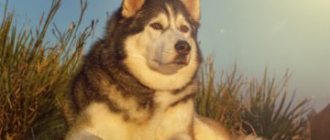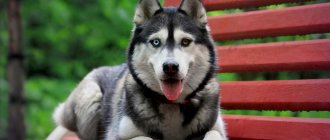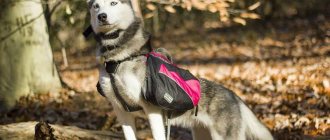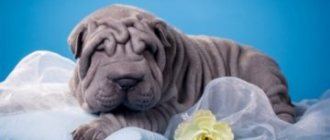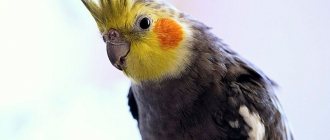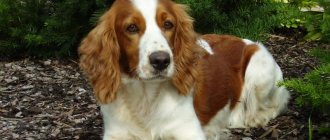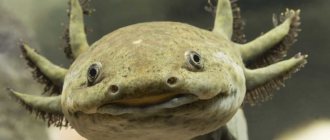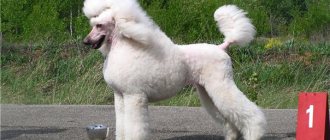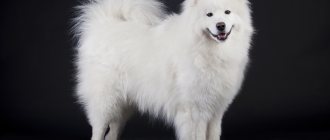Each dog breed is interesting and beautiful in its own way. But some people need a watchman for their apartment, some get a dog to attend various exhibitions and competitions, while others do not pay attention to the breed at all and take their faithful friend from the shelter. But if you want a smart, energetic furry friend to live with you, whose beauty will outshine all the most famous models, then the choice in this case is obvious - you need a husky. However, before adopting a dog from a kennel, we advise you to study all the characteristics of this breed, as well as learn a couple of secrets on training, raising and caring for a fluffy one. In this material we have collected everything you need.
Description of the breed
The ancestors of the Husky are sled dogs originally from Chukotka. One of the peoples who kept “shaggy horses” were the Eskimos. English sailors from merchant ships who visited those parts pronounced the name of the nationality as “huskimos”. Hence the name of the dogs.
In the mid-nineteenth century, the hardy dogs were brought to Alaska, where they were crossed with local breeds. The result was a medium-sized dog with a harmonious build, thick hair and a fluffy tail curled up. According to the breed standard, recorded in the 30s of the twentieth century, a husky must have:
- triangular erect ears;
- muzzle tapering towards the nose;
- strong short-haired limbs;
- almond-shaped eyes of brown or blue (multi-colored eyes are allowed);
- scissor bite;
- straight back with well-developed lower back;
- wide chest.
Huskies include:
- Siberian variety (height up to 60 cm, weight up to 28 kg);
- Alaskan Malamute (up to 65 cm, up to 45 kg);
- Klee Kai (up to 42 cm, up to 10 kg);
- Akita Inu (up to 67 cm, up to 50 kg);
- Samoyed (up to 57 cm, up to 30 kg).
The length of the coat depends on the type of husky and its pedigree. Purebred Siberians and Malamutes are classified as shorthaired. The standard does not recognize long-haired beauties, however, as a pet (not a show dog), furry strongmen are very popular.
Appearance of Siberian Huskies
Experienced dog handlers believe that the standards of the breed are met not by show animals, but by mounts. British dog breeders specialize in breeding such huskies.
Head
The skull is small. The bridge of the nose is straight. The stop is clearly defined. The muzzle tapers evenly to the nose, which is neither square nor pointed. The almond-shaped eyes are set obliquely. The color of the iris is brown or blue. There are heterochromic dogs. Triangular ears are always raised up. The animal's teeth have a scissor bite.
The husky's head tapers towards the nose, the eyes are set askew.
Neck
The husky's neck is of medium length. During movement, this part of the body tilts in such a way that the head moves slightly forward.
Frame
The dog has a strong back with a straight line from the croup to the shoulder blades. The chest is deep, allowing it to protect the animal’s heart. The ribs are widely spaced from one another.
Limbs
The Husky's forelimbs are straight and parallel. The elbows should not be pressed against the chest or turned outward. The hind limbs are also parallel.
The knee joints are flexible. The paws are medium in size and oval in shape. The skin on the pads is thick.
Tail
The tail should be slightly lowered when calm. This organ is located below the line of the back. If the animal experiences excitement or interest, the tail becomes mobile, rises and curls into a ring.
The tail becomes mobile if the dog is excited.
Wool
The coat of this dog breed is medium length. She doesn't hide the lines of the body. The undercoat is thick and soft. Color varies from white to black. A characteristic feature of the breed is the dark “mask” on the face.
How to properly care for and raise a husky puppy?
Raising a Husky puppy into an adult, well-trained dog will require patience and endurance. Hasyats need care and constant supervision, like small children. He must understand the purpose of the tray, know his place, remember his nickname and learn to be alone. You will have to endure the dog's hysterics after the owner leaves. You can’t go back and console him, otherwise the “protest rallies” will never end.
Grooming (combing, examining and cleaning ears and teeth) begins as early as possible so that the puppy perceives these procedures as a necessary part of life. The first vaccinations must be given by the breeder. Vaccination documents must be obtained upon purchase. The nursery usually explains which vaccinations need to be done and when.
The puppy must know that the person is in charge, and it is he who sets the rules.
Tips for caring for a puppy
When caring for hasyats, you should pay attention to:
- Grooming will bring less worry to both the owner and the pet if you start it from the very first day.
- Ears are the weak point of the Siberian beauty. They are inspected and cleaned a couple of times a week.
- The soft baby fluff is combed out very carefully, with a special brush, 1-2 times a week. After a year you need to comb it every other day.
- They bathe the Khasenysh as rarely as possible. Regular brushing is enough to get rid of dust and dirt. Bathing with shampoo (special, not “human”) is necessary approximately once a year.
- The puppy's nails are trimmed very carefully so as not to damage the skin. If the dog often runs on hard surfaces, then the nails do not need to be cut; they grind down on their own.
- It is necessary to regularly check your dog for fleas, ticks and other parasites.
If you have no experience caring for puppies, you should seek advice from a veterinarian. A specialist will tell you how to make care safe and comfortable.
What does a husky puppy need?
Before a charming baby appears in the house, you need to take care of many things:
- house or bed;
- tray;
- diapers;
- toys;
- collar, leash;
- bowls;
- care products (brushes, combs, shampoo);
- special toothbrush and toothpaste.
Separate bowls are needed for food and water. It is better to choose stainless steel containers with a stable design. The puppy will quickly learn to turn plastic bowls over and will definitely try to chew them.
Personal place for husky
A house or bed is a zone of comfort and safety. Here Khasenysh feels protected. The baby's personal space should not be too big or small. The dog must stand, lie, and turn freely in it. There are sliding structures that can be expanded as your pet grows.
A soft blanket or pillow made of safe materials is placed inside the house (the baby will definitely try them out). The litter needs to be looked after: cleaned or washed. This is worth remembering when choosing material.
The bed is installed in a quiet place, away from drafts, equipment or noise sources. However, it is impossible to isolate a Khasenysh: the dog must be able to see what is happening, observe the owner and family members. Otherwise he will feel lonely.
The first acquaintance with a personal place will be easier if you put several toys on the bed. You need to choose objects that are large enough and smooth enough so that the puppy does not swallow them or get hurt. The baby is brought to the bed, slightly pushed and pronounced “Place.”
An adult husky cannot live in a house, with the exception of specially bred “apartment” species (Klee Kai, American Eskimo). The dog needs a spacious enclosure or booth.
You cannot use your puppy's personal space for punishment.
Breed characteristics
Today, huskies are divided into three types:
- sledding;
- sports;
- exhibition
The driving type is considered the most correct and, one might say, official. At one time, it was actively bred by the British, who still hold the lead in this matter. We decided to give a detailed description of the breed: from the tip of its fluffy tail to its wet nose.
Let's start with the size of the dog. Huskies can be called a medium-sized breed - the height of a male at the withers is from 54 to 60 centimeters, of females - from 51 to 56 centimeters. The weight of dogs ranges from 21-28 kilograms for males and 16-23 kilograms for females.
The husky's head fully matches all the proportions of the body. The skull of these dogs is small, gradually tapering towards the eyes, and the muzzle itself is not very elongated. A funny feature of these dogs is their facial expression - these fluffies are somewhat reminiscent of mischievous children who love to fool around.
We can talk about husky eyes forever. And we're not just talking about color. The almond shape, which is set slightly obliquely, makes the look of this breed truly magical. The color of the iris of a husky's eyes is quite different - they can be brown, blue and heterochromic (eyes have different colors).
Ears are one of the favorite parts of Husky owners. They are medium in size and sit high on the dog's head. They stand firmly, and their rounded tips point upward. If you get yourself a husky, you will notice how you will have a desire to constantly knead those warm and fluffy ears.
The husky's neck is of medium length. When the dog is standing, the neck is in a raised position, but when walking, the head drops slightly and protrudes forward.
Since they are a fairly hardy dog breed, they need a big heart. Therefore, the Husky's chest is quite deep, which is why the chest appears large and wide. These dogs have a straight back from the shoulder blades to the croup.
The husky's tail can be compared to a fox's, since it also has a rounded shape due to the hair being the same length. Depending on the mood (as with all dogs), the tail can be raised, lowered, or completely curled in relation to the back.
The limbs, both front and rear, are very mobile, have well-developed and strong joints, they are placed evenly and at a moderate distance from each other, so that the dog does not seem funny and absurd. The paws themselves are oval-shaped with a lot of fluff between the toe pads.
If you pet a husky, for a split second it may seem like you are touching a cloud. This effect is achieved thanks to the soft and thick undercoat. The main coat of these dogs reaches medium length and, like the undercoat, it is quite soft and smooth. Huskies can be found in a variety of colors - white, brown, black, gray with stripes, markings and other fancy “patterns”.
pixabay.com/pixel2013
Features of keeping and caring for an adult husky dog
If a husky lives in a city apartment, he needs to walk at least 1.5-2 hours a day. Moreover, the walk should be active. In a private home, the pet gets more freedom, but it is still necessary to walk with it. Adult huskies are fed once a day, but puppies up to a year old will have to be fed several times a day.
Teeth care and brushing
There is usually no need to care for the teeth of a healthy husky with good heredity. Plaque can form from dietary errors. If this happens, you need to regularly brush your teeth with a special brush and toothpaste.
Ear and eye care
The eyes and ears are examined regularly. Curious dogs often dig through piles of leaves, grass, or debris. Dirt or foreign particles may get into your eyes and ears. After walks, it is advisable to check the pet’s condition and, if necessary, rinse with a cotton pad or soft cloth. Usually clean water is enough, but you can care for it with chamomile decoction or strong tea.
Nail care, when to cut them
If the dog spends a lot of time outside and often runs on hard surfaces (asphalt, concrete, stone), the claws wear down on their own. Nails need to be trimmed when they begin to curl down. They cut it very carefully, millimeter by millimeter, so as not to harm the dog. It is safer to consult a veterinarian for this.
Hygiene procedures, hair care
Constant brushing not only keeps the coat clean, but also has a positive effect on the skin. Movements with the comb and brush massage the body, causing a slight rush of blood. The sooner you start combing, the easier it is.
The first time should be bathed after the baby has completely settled into the house. This may be stressful for him. Khasenysh plunges into water for the first time and panics. You should not bathe your Husky more than once a year. The exception is dogs with a white coat. But here, too, caution is needed - shampoos and water dry out the skin and deprive the coat of its protective properties.
Walking outside
The Khasenysh is taken outside for the first time after the quarantine ends after the second vaccination. You need to walk your pet for at least forty minutes twice a day. The more physical activity and new experiences the dog gets, the less destruction he will cause at home. In winter there are no problems with walks, but in summer you should choose shady, cool places or take your pet out early in the morning and very late when the heat subsides.
Maintenance and care
Husky does not require special care. You can bathe your dog no more than once a month. More frequent hygiene procedures are necessary for animals with white fur. At the same time, the dog should wash its paws after every walk.
It is recommended to keep a Husky dog in an enclosure.
The pet feels the need for physical activity. If the owner lives in a country house, the husky needs to build an enclosure. An animal can be outside all day without harm to its health. In a city apartment, it is advisable for the owner to keep the husky in a cage. However, your pet should be accustomed to restrictions from childhood. The owner should buy toys so that the puppy left at home does not feel lonely.
Despite the fact that the dog does not attack passersby during a walk, the pet needs to wear a muzzle. The pet picks up food thrown on the ground. The leash for walking should be long.
Dog diet
Your pet's daily menu may include both dry food and natural products. When using ready-made mixtures, you must adhere to the norm indicated on the packaging. It is advisable that the food be selected by a veterinarian, taking into account the health and age of the dog. Experts advise buying premium mixtures. If the owner prefers to feed his pet natural products, he needs to prepare his food separately. Giving food “from the table” is prohibited. The menu should include:
- Meat. This product makes up at least 60% of the daily diet. You should buy lean meat - turkey, chicken, beef. If the owner is confident in the high quality of the product, it can be given raw. But it is advisable to boil or bake the meat.
- Cereals. Huskies are recommended millet, rice and buckwheat. The pet is allowed to eat not only the cereals themselves, but also flakes prepared from them. The presence of flavoring additives (dyes, flavors) is unacceptable. Cereals should take up no more than 20% of the daily diet.
- Fish. The pet is fed boiled or baked food 2-3 times a week. The fish should not have small bones.
- Dairy products. Kefir, cottage cheese, yogurt and curdled milk with a low fat content (up to 1.5%) are suitable for dogs. This food cannot contain synthetic flavorings. Fermented milk products should be given in the first half of the day.
- Vegetables. Huskies love pumpkin, zucchini, turnips, and cabbage. These vegetables need to be cooked. Cucumbers and carrots are given raw, to which a small amount of vegetable oil is added. Fresh tomatoes help your pet get rid of tartar and plaque. Vegetables take up up to 30% of the daily diet.
- Chicken eggs. They can be given boiled or raw. It is recommended that your pet eat eggs no more than once a week.
Lean meat and food should be included in a husky's diet.
By-products (liver, lungs, heart) are considered junk food. They are allowed to be given infrequently and after preliminary heat treatment.
One serving size for a husky is 2%-3% of its weight.
The dog should have free access to clean drinking water. The liquid in the drinker needs to be changed at least once a day.
What not to feed
Mixed nutrition should not be used. It complicates the digestive tract and worsens overall health. Dogs should not be on the menu:
- fatty foods;
- sweets;
- semi-finished products;
- preservatives;
- cold or hot food.
It is forbidden to feed the animal bones. They injure the oral cavity and digestive tract. Tomatoes are given no more than once a week. These vegetables can not only be beneficial, but also cause an allergic reaction. You should not give your pet economy class food. The grain filler that forms the basis of such a product clogs the dog’s intestines and interferes with its emptying.
How many times a day to feed
Puppies up to 2-3 months are fed 5-6 times a day. Then, during the first year of life, the number of meals per day is gradually reduced.
The dog is fed 1-2 times a day; the husky has a poor appetite.
Animals over 12 months old are fed no more than 1-2 times a day. Huskies have a poor appetite. The animal may not eat for 1.5-2 days. In the absence of apathy, weakness and other dangerous symptoms, refusal to eat should not be considered a sign of illness.
Where should you keep your dog?
It is hot in a city apartment for a Siberian, and the fur and skin suffer from the high temperature and dry air. And the owners will have a hard time: wool will be everywhere, especially during the molting period. Huskies usually shed once a year, but in unfavorable conditions they can shed year-round. Only small species are suitable for an apartment; they are much easier to care for.
The best “home” for an active large dog is a spacious enclosure or kennel in the garden of a private house. To set up an enclosure you will need a chain-link mesh made of wire no thinner than 5 mm, preferably stainless steel. You cannot paint the fence so that the dog does not get poisoned (he will definitely try to bite the barrier).
Huskies love earthworks. They make tunnels with incredible speed and strive to escape at the first opportunity. Therefore, the mesh must be installed in the floor or foundation. The floor can be earthen or paving slabs. A canopy from rain and sun is a must. It is important that the enclosure is well ventilated. One, maximum two walls can be blank, the rest can be made of mesh.
Care and maintenance of the Siberian Husky
Keeping a pet consists of feeding, walking, playing and training, grooming and regular visits to the veterinarian. You cannot raise a Khasenysh in isolation. If he does not learn “from the very beginning” to communicate with other animals, not to be afraid of city noise and large crowds of people, serious mental problems may arise in the future.
At home
Caring for a husky in a private house or apartment is no different. The only difference is the comfort of the dog and the owner. For urban conditions, small subspecies of the breed are chosen, and large dogs can be kept on a personal plot.
In a private house
Being outside (in an enclosure or kennel) is an important condition for keeping frost-resistant huskies. The dog is much more comfortable in his own home; he can run freely around the entire area. The only thing you have to keep an eye on is the condition of the fence. If the fence around the territory is poorly reinforced or not buried in the ground, the husky will dig under the ground and break free.
Siberian Husky, a beautiful, singing and friendly dog
History of the breed
Husky – if we translate this word from English we get – “husky”. These beautiful and well-built dogs do not bark, but growl.
Another meaning of the word “husky” was the name of the Eskimos, derived from the abbreviated “eski”. In addition, huskies are the name given to dogs used for sledding, that is, sled dogs. All of them are characterized by very thick hair, erect ears and a sharp muzzle, as well as a tail curved upward.
The Chukchi, living in the northeast of Siberia (presumably 3-4 thousand years ago), bred dogs (domesticated wolves) for use in hunting and for protection. For the first time, Siberian huskies or, as they were called in America, “Chukchi dogs” were brought to Alaska at the beginning of the twentieth century.
One of the merchants in Alaska (his name was Gusak) brought dogs (light and not very large) from Siberia and decided to use them in a sled team, rightly believing that they had enough strength for this, and their short stature would allow them to develop good speed. Thus began the sledding history of using this breed of dog.
Characteristics of the breed
These are very beautiful and well-built animals, distinguished by restraint and a pronounced sense of self-esteem, at the same time active and loving games. Dogs , namely females, are very smart and strongly attached to humans, while males are more reserved.
Due to the fact that representatives of this breed have lived side by side with humans for a very long time, and in the cold of winter, they have long warmed the home of the Chukchi and their children with the warmth of their bodies, they are characterized by friendliness and affection for children.
However, another characteristic feature of the husky is its ineradicable hunting instinct. What must be taken into account by animal owners living in the city in order to avoid unpleasant situations when suddenly a dog that has never been on a hunt and has not been trained to do so begins to hunt for neighbor’s cats or decorative rabbits.
At the same time, it is not recommended to use this dog for hunting, since, despite its excellent hunting instinct and, accordingly, the result, it will not bring prey, but will itself take advantage of the result of the hunt.
This habit of eating caught game is due to the fact that in the north, sled dogs are fed only during the snowy season, and the rest of the time they are released “to free range”, where they get their own food.
Another feature of Siberian Huskies is their complete lack of aggression and friendliness towards people. Therefore, they are absolutely unsuitable for security work.
With proper nutrition and care, both husky puppies and adult dogs have virtually no odor, which is quite good if they are kept at home. It can sometimes appear in hot weather if the dog gets wet.
Despite the apparent restraint of dogs of this breed, they cannot be called silent either; they express their emotions with a whole range of sounds, from growling to “dog singing”.
In addition, future owners need to understand that initially this was a working breed of dog, adapted to great physical activity, therefore, to keep it in good shape, it needs regular exercise, and even better, joint jogging.
These beautiful dogs love company and communication, so if you have one dog, it will constantly demand communication. For the same reason, there are frequent cases of running away from home in search of their pack.
It should also be noted that huskies love to dig and can overcome various obstacles very well, which can also present certain problems when living in rural areas.
Is it possible to put it on a chain?
You can't keep a husky on a chain; he doesn't know how to sit in one place. This option is only suitable for guard breeds. The optimal equipment for restraining your pet is a collar, leash and muzzle for walking. Leather or nylon are suitable for the first collar. The length of the leash is 1.5-2 meters. The size of the collar is suitable if two fingers of the owner fit between it and the pet’s neck. Without a collar, a dog can only be released in a fenced area.
Only sports dogs that run many kilometers in a harness per day can be chained.
What to feed a puppy and an adult dog?
When caring for a husky, feeding becomes a stumbling block. If left unchecked, pets eat everything all the time, quickly gain weight, become clumsy and get sick. Puppies are fed 5-6 times a day at first, and after 3-4 months - no more than 4 times. By six months the number of feedings is reduced to 2-3, only two remain per year, and after that the dog will have enough once a day.
Hasyats can be given:
- dairy products;
- meat, fish;
- porridge;
- vegetables.
Raw cartilage, bones, offal and eggs are added to the diet of an adult dog. You cannot feed your pet with leftovers from the owner’s table - human food is too fatty and contains a lot of harmful chemicals (preservatives, dyes, flavoring additives).
Huskies are prohibited:
- pork, lamb;
- smoked, spicy foods;
- butter;
- River fish;
- sweets (all, including the so-called low-fat ones);
- grapes and raisins;
- any canned food, except special dog food.
You can feed with natural products or prepared foods (dry mixtures, canned food). But it is strictly forbidden to mix these two types of feeding.
Natural nutrition
Tasty, healthy, but very troublesome and expensive. Huskies need to be cooked separately; human diet is not suitable for her. Products must be fresh and of high quality. For example, store-bought chicken loaded with preservatives can cause allergies.
Dry food
Simple, fast, but not very useful. And not too cheap. Low-quality food is not suitable for Huskies - they contain many unnecessary and sometimes harmful components. Ready-made food must be premium. With this regime, the pet needs to drink a lot so as not to get dehydrated.
Feed, diet and hygiene
Until the puppy reaches two months of age, it needs to be fed about six times a day. As the dog gets older, the number of meals decreases: up to four months - five times, six - four times, then you can switch to three meals a day. From about 10-11 months, dogs eat twice a day.
There is no point in experimenting with food. It is better to ask the breeder or veterinarian in advance how to create a correct and healthy diet for your baby. In most cases, dogs are given special balanced dry food or premium canned food for dogs with increased activity. It is better to avoid cheap food altogether, since it often contains a huge amount of starch, which is unsafe for the dog’s stomach.
However, even after you have bought high-quality food for your dog, it is better to monitor its well-being for a while and, if necessary, adjust its diet.
Huskies can also be fed natural food. However, we would like to warn you right away that this is a very expensive and difficult task, because about 60% of the diet of dogs of this breed is meat. It is also worth approaching the choice of meat products very responsibly. Please note the prohibitions:
- A husky may be allergic to chicken, so it is better to exclude it;
- Dogs of this breed cannot eat lamb and pork.
Huskies can be fed lightly scalded or raw beef, as well as rabbit or turkey meat. In addition, a couple of times a week you can pamper your dog with boiled chicken egg yolks, vegetables (except potatoes) and fermented milk products. Don't forget about fish oil and vegetable oil - add them to the food in small quantities.
However, even the most varied diet will not provide Siberian Huskies with the entire range of useful microelements and vitamins. They are prescribed by a veterinarian, so there is no need to buy anything yourself.
As for hygiene, the owner’s main task is to brush the dog (especially during shedding), trim the nails and promptly clean the teeth from plaque and stones. This can be done both at home and in the clinic. But these dogs do not need bathing as often as other breeds. The whole point is the ability of wool to self-clean, and the ingress of water, on the contrary, leads to a violation of the alkaline balance, which provokes the appearance of an unpleasant odor.
Based on all the above rules, we can conclude that the dog’s health and well-being largely depends on care and proper nutrition.
The right regime for a husky
Khasenysh sincerely believes that getting up at four in the morning is good. Convincing him that he needs to sleep at least a little longer is difficult. Approximate daily routine (the pet will adjust it anyway):
- getting up at the same time (forget about weekends and holidays);
- immediately after sleep, an active one-hour walk (preferably jogging);
- upon return, wash paws;
- breakfast;
- another exit to the street for natural reasons (15-20 minutes after eating);
- During the day, it is advisable to feed the puppy and play with it (you can invite friends and acquaintances if the owner is at work);
- It is not necessary to feed an adult dog during the day, but it won’t hurt to entertain him (you can leave the radio or TV on);
- in the evening, clean up the mess, wipe up puddles, change the water and feed (the interval between feedings is 8-12 hours);
- about forty minutes after dinner - a long and active walk (can be combined with training);
- before going to bed, another sanitary walk (short and calm).
In general, dogs sleep more than people, but waking their owner at dawn is an almost immutable law. The daily routine should include walks (total duration 2-3 hours), communication with other dogs, games, classes and training.
Raising and training a dog
Education begins from the first day the baby appears in the house. Khasenysh is immediately placed in a tray covered with a diaper and is not released (with persuasion, affection, but not force or screaming) until the puppy goes to the toilet. For this, the Khasenysh is sure to be praised and treated. The diaper is not changed so that the characteristic smell remains.
The baby gradually remembers his nickname (a short name is easier to remember), masters basic commands, learns to go to the toilet on the street, and stay close to his owner. From about six months you can start training with a dog handler. Training a dog on your own is not easy. Mistakes and gaps in education will cost you dearly in the future.
History of the breed
The Siberian Husky, or simply husky, has been living alongside people for several centuries. Moreover, they appeared precisely thanks to the inhabitants of the Russian far north. These people especially needed a hardy and fast dog that would help them transport prey from hunting grounds to their homes. Therefore, they bred a special breed with thick fur, good eyesight, great strength and boundless energy.
The active spread of the breed began in the 20th century, when on the American continent they learned about wonderful dogs that can work very well and harmoniously in a harness, while listening to people and helping them with housework. In addition, in Alaska, huskies began to be actively used in various competitions and sled races.
In 1925, a truly legendary event occurred when professional racer and dog trainer Leonard Seppala was able to take a cure for diphtheria to a small town called Nome. Thanks to the keen sense of smell and endurance of the dog Togo, who stood at the head of the entire team, the dogs were able to overcome a huge distance in the harsh conditions of severe frost and snowstorm.
The second section of the distance was destined to be overcome by the second team, led by the legendary dog Balto. Remember the old cartoon "Balto", which told the story of a brave dog? This is exactly what we are talking about!
Thanks to Togo and Balto, the city residents were saved from a dangerous disease, and the huskies forever secured their status as loyal friends and most reliable helpers. By the way, in memory of the feat of these dogs, a monument was erected at the entrance to the Cleveland Zoo, so everyone can now see these furry heroes.
Unfortunately, in the USSR the breeding of this breed was considered unpromising, and the selection of sled dogs was stopped. The same cannot be said about the USA, where people are really into sled dog racing.
In order to set records by a wide margin, Siberian Huskies began to be crossed with other breeds of sled dogs. In competitions they showed better results, but never received recognition due to their strong differences from real Siberian huskies.
However, powerful cars began to replace sled dogs and husky sleds became less and less in demand. Everything changed overnight when two prominent figures in the New England Sled Dog Club, Lorna Demidoff and Eva Seeley, introduced us to a black and white dog with piercing blue eyes at one of their shows.
This breed immediately captured the hearts of people and, starting around the 1970s, huskies began to be bred to participate in canine beauty contests. In addition, it turned out that the furry ones are very loyal friends who can easily get along with a person in an apartment.
In the 1990s, huskies returned to their historical homeland - Russia. In 1997, 14 huskies were presented at one of the largest exhibitions, and a few years later their number had already “exceeded” a hundred. Therefore, now it is not so uncommon to meet a happy husky on the street of your city.
By the way:
In Chukotka, people still resort to the help of sled dogs. True, they use the descendants of huskies - Chukchi sled dogs. They can be called an aboriginal breed, which was bred specifically for living and working in a harsh climate. Outwardly, she vaguely resembles a husky, but her body is stronger and more resilient. This is a rather rare breed and is practically never found outside of Chukotka.
Diseases and vaccinations
With good heredity, the health of a husky is not a cause for concern. True, each subspecies has its own weak points: eyes, ears, diseases of the larynx, problems with the coat. The first vaccinations must be given by the breeder. Further, it is better to entrust the concern about the choice of vaccine and timing of vaccinations to the veterinarian.
Despite their frost resistance, huskies can catch a cold. Their thick coat takes a long time to dry after bathing. You should not let your dog go outside until the fur is completely dry. Another problem is the summer heat. Your pet should always have access to water and it is better to limit its activity for a while.
Most health problems arise from lack of physical activity and obesity.
Health and illness
Siberian Huskies have long been famous for their good health, because the breed was specially bred for harsh winter conditions. However, this does not mean that after purchasing a husky you can completely forget about vaccinations, visits to doctors and possible illnesses.
First of all, when purchasing a puppy, study its entire pedigree to make sure that its parents and closest canine relatives did not have congenital diseases that could be passed on to it. Unfortunately, these dogs now have many diseases that are transmitted at the genetic level: diabetes, cancer and cataracts.
It often happens that these dogs suffer from epileptic seizures. Modern medicine does not allow quadrupeds to be completely cured, but a doctor can still reduce the frequency of attacks.
To avoid health problems for your furry friend, you need to undergo routine examinations with veterinarians, get vaccinated and independently monitor the animal’s condition:
- examine ears, eyes and teeth;
- care for the coat and monitor its changes;
- monitor the health of paws and joints;
- control the dog’s weight, since underweight or overweight has a detrimental effect on the animal’s condition;
- carry out deworming and stop the animal’s attempts to eat its own or someone else’s feces.
By the way:
Don't forget that huskies are northern dogs. Therefore, in the summer it is better to choose shady places for walks to avoid overheating of the dog.
If you notice that your dog has become less active, has lost his appetite and refuses to drink water, you should contact your veterinarian. If a husky receives proper care and attention, the life expectancy of a dog of this breed can exceed 15 years.
pixabay.com/albertlsy7101
Friend, athlete and just handsome
A well-groomed and well-mannered husky is the pride of the owner. To achieve such a result, you need unlimited patience, love and respect for the dog, rigor and discipline. The “technical” side of care usually does not cause problems if true friendship develops between the dog and the person.
Huskies always choose the family member with the strongest character as their leader. At the same time, a completely different person can feed them, care for them, and take them for walks. Dogs intuitively sense a leader. Sometimes owners are puzzled by the choice of pet, but the “four-legged psychic” is never wrong. The chosen leader will easily achieve obedience and submission if he treats the animal with respect.
